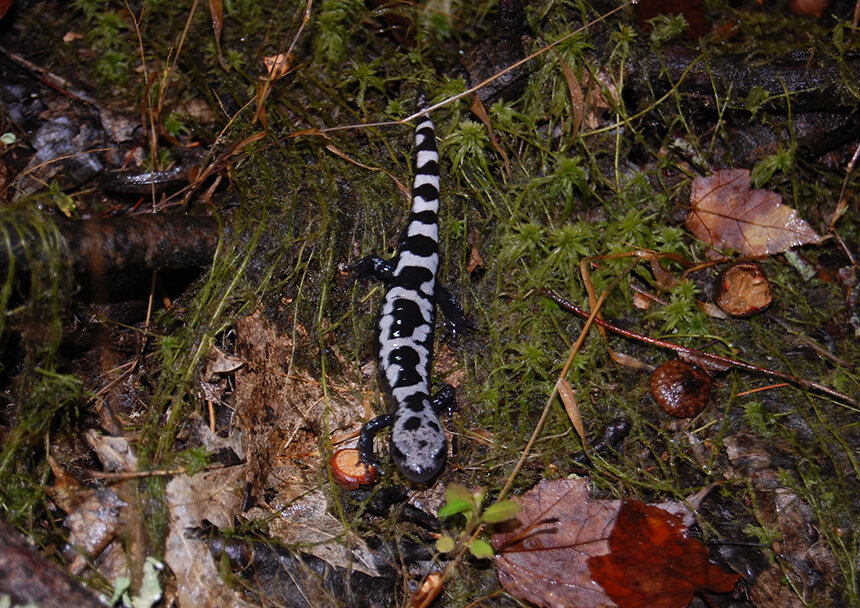Search for Rare R.I. Salamander Happens in the Dark
Marbled
salamanders are the second-largest salamander in the region. (Todd
McLeish/ecoRI News photos)
By
TODD McLEISH/ecoRI News contributor
After dark at a well-hidden vernal pool, Peter Paton shined his
flashlight back and forth at the moss-covered ground around the nearly-dry pond
basin. He was searching for marbled salamanders, the only autumn-breeding salamander
in New England, and one that is seldom seen except on rainy fall evenings. It
didn’t take him long to spot one.
“I
got one,” he called out. “Over here.”
Marbled salamanders,
which grow to about 3.5-4.25 inches, are the second-largest salamander in the
region — after only the spotted salamander — and their attractive
black-and-white patterning makes them unmistakable. The one Paton found, a
male, was on his way out of the pond basin, indicating that the animal had
completed his mating duties and was headed to the forest to spend the winter
underground.
Female
salamanders were likely hidden in the sphagnum moss around the pond, where they
remain for a month or more to guard their eggs until rain fills the pond and
the eggs are protected from predators and the elements. The eggs hatch within
days after being covered in water, and the larvae overwinter in the pond.
Paton, a professor of natural resources science at the University of Rhode Island, was confident of finding marbled salamanders at the Richmond site, since it was a place he studied and monitored in 2000 and 2001, when he and colleagues conducted an amphibian survey of 137 vernal pools around the state.
Marbled
salamanders were found in just four of the pools, however, making it one of the
rarest pond-breeding amphibians in the region.
Previous
efforts in the 1980s and ’90s by Chris Raithel, a wildlife biologist at the
Rhode Island Department of Environmental Management, documented as many as 50
marbled salamander breeding sites in the state, mostly in Kent and Washington
counties. There are no records from Bristol County or from areas adjacent to
Narragansett Bay and few from the Blackstone Valley.
“The
present localized distribution of marbled salamanders in Rhode Island may be
related to habitat fragmentation and patch isolation,” Raithel wrote in his
2019 book Amphibians of Rhode Island.
“If this effect is real, the species is secure only in the larger contiguous
habitats of southern and western Rhode Island, and additional range retraction
should be evident to future generations.”
Marbled
salamanders require a very specific habitat for breeding: ponds that are
surrounded by sphagnum moss and dry up in the summer, keeping fish and large
dragonfly larvae from inhabiting the pond and preying on the salamander larvae.
“They
tend to like relatively small ponds, and there aren’t many sites available that
fill their habitat requirements,” Paton said.
In
addition to habitat fragmentation, road mortality is also a significant concern
for the species, because they are often crushed by vehicles as the adults cross
roads to reach their breeding ponds or as juveniles disperse to find
territories.
On
the other hand, Paton said it’s possible that the changing environmental
conditions associated with the warming climate may make southern New England
more favorable to marbled salamanders in the future. Their current range
extends as far south as northern Florida and eastern Texas, and populations in
warmer climates tend to be considerably larger than those in Rhode Island.
“They
aren’t very tolerant of the cold, so we’re at the northern limits of their
range,” Paton said. “The larvae don’t grow much in the winter because it’s too
cold, but once wood frogs arrive to breed in early spring, the salamander
larvae feed on the frog tadpoles as their main fuel source to undergo
metamorphosis.”
After
metamorphosis, the salamanders leave their ponds and spend the rest of their
lives in the forest, except for brief breeding periods each fall.
Marbled
salamanders require a very specific habitat for breeding and they are not very
tolerant of the cold.
Despite
how few marbled salamander breeding sites were found during the last amphibian
survey, a recent graduate student at the University of Massachusetts Boston
thinks a new survey method may detect the salamanders more effectively than
traditional sampling methods.
Jack
He, who graduated in May, used eDNA — environmental DNA collected from water or
soil — to detect the presence of marbled salamanders even when the animals
could not be seen.
“Everything
sheds DNA in one form or another, like from skin cells or blood, and they
release it into the environment,” He said. “Ideally, we can collect water or
soil samples containing those cells and extract that DNA and sequence it to
determine what species are present.”
He
detected marbled salamander DNA in a number of water and soil samples from
vernal pools in western Massachusetts. He calls it a less labor-intensive
method of determining if the salamanders are present at a site than using
dipnets to capture larvae in the spring, which is how Paton conducted his
survey.
“I’ve
done dipnet studies and compared them to eDNA, and I found that eDNA was a bit
more effective,” He said.
Paton,
however, isn’t convinced.
“My
impression is that larvae are relatively easy to find, but I could be biased,”
he said. “Maybe they’re in there and I missed them a lot. But however you do
it, I suspect that marbled salamanders are still fairly rare in Rhode Island.”
Rhode
Island resident and author Todd McLeish runs a wildlife blog.

